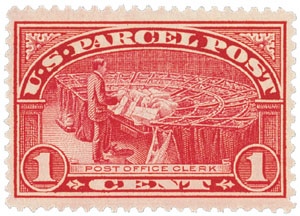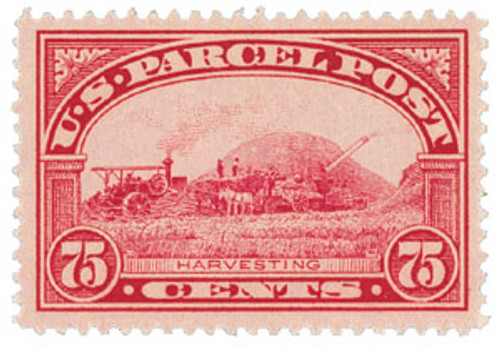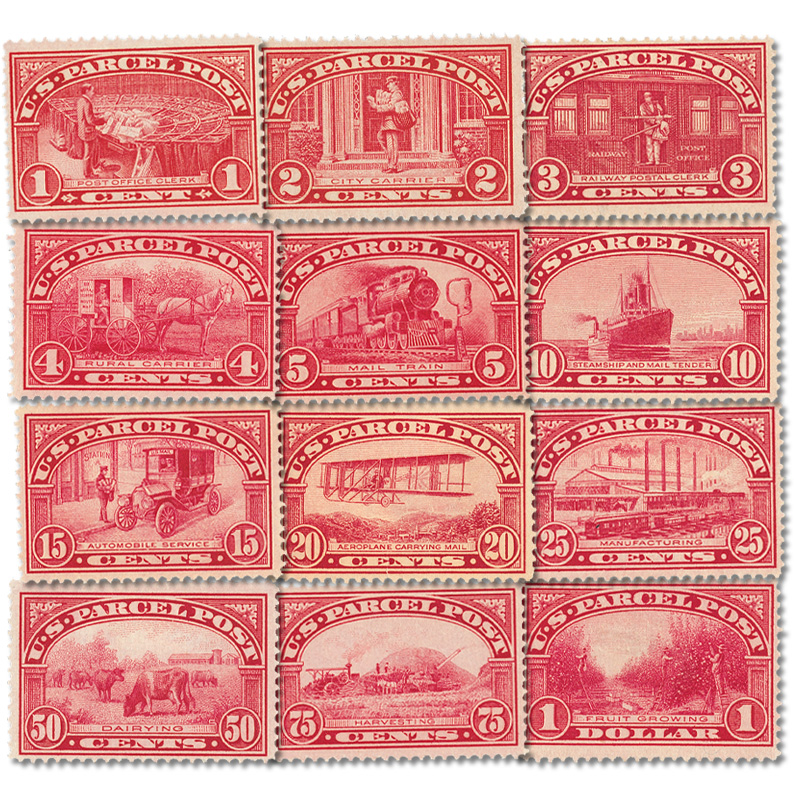
# Q11 - 1913 75c Parcel Post Stamp - Harvesting
City: Washington, DC
Printing Method: Engraved
Perforations: 12
Color: Carmine rose
Parcel Post Service Begins

On January 1, 1913, the US Post Office Department initiated its Parcel Post Service for fourth-class mail.
Before 1912, private companies controlled package deliveries throughout the United States. Because delivering packages in larger cities could make more money, these companies often overlooked small towns.
That changed when Congress passed a law on August 24, 1912 creating a parcel post service for fourth-class mail. Instead of private companies, the Postal Department would now deliver packages to all parts of the country. Rural Americans would now have access to goods and merchandise they could not have gotten before. This gave rise to mail order giants like Sears, Roebuck and Co., and Montgomery Ward and Co.
Parcel Post service could be used for sending items weighing 16 ounces or more through the mail. The mail is divided into four classes, with Parcel Post making up the fourth class. Almost any type of merchandise can be mailed parcel post, including day-old chicks, baby alligators, and honeybees. Only items that could be dangerous to handle cannot be sent through Parcel Post.

Special Parcel Post and Parcel Post Postage Due stamps were produced for the new service. Like other Postage Due stamps, these showed that amount of postage due on packages that were insufficiently prepaid. The recipient of the package rather than the sender paid this amount. The Parcel Post Postage Due stamps were all dark green with a large numeral indicating the amount to be paid.
The Parcel Post service began on January 1, 1913. The special Parcel Post stamp were required on all fourth class packages. The stamps were an instant success. During the first five days, post offices reported that they handled over four million packages. However, despite this early surge in popularity, the stamps would quickly lose favor. Philatelic author Henry M. Gobie later dubbed these stamps the “Fourth Class Follies of 1913.”

Postal employees objected to the Parcel Post stamps for several reasons. They stated the large stamps just didn’t fit where they needed to be applied. They also complained that they were all the same carmine color, making them difficult to distinguish one from the other. And they also disliked the odd number of stamps (45) per sheet.
As a result, the use of Parcel Post stamps for this designated purpose ended in June 1913. But the rural delivery of parcels by the US Postal Service continued. The only difference was that regular stamps could be used on parcels, and Parcel Post stamps could be used on regular mail. The stock of Parcel Post stamps was allowed to run out. In use for just six months, the Parcel Post stamps were one of the shortest-lived US series.

Though these stamps had caused confusion, no one complained about their beauty, as the pictorial centers (vignettes) were some of the most interesting yet produced. The lower denomination stamps paid tribute to the postal service, showing mail carriers, clerks, and other vehicles that carried the mail. One Parcel Post stamp featured the first airplane ever shown on a government issued stamp. The four Parcel Post stamps with the highest denomination featured manufacturing and agriculture. The 75¢ stamp features a grain-harvesting scene. The threshing machine and team of horses stand in front of a large pile of grain. The design honored the farms of the Midwest. This stamp was the last of the series to be retired, and was still delivered to some post offices until 1922.

Parcel Post stamps may have been short lived, but the stories surrounding the US parcel post are not. One such story tells of a 48½-pound package (just under the 50-pound limit) sent from Grangeville to Lewiston, Idaho. The package contained four-year-old May Pierstorff! May’s parents wanted to send her to visit her grandparents, but found the train fare a bit steep. They decided to mail her for just 53¢. They attached the stamps to May’s coat, and she rode the entire way in the mail car. The mail clerk on duty, Leonard Mochel, delivered the girl to her grandmother’s door!
City: Washington, DC
Printing Method: Engraved
Perforations: 12
Color: Carmine rose
Parcel Post Service Begins

On January 1, 1913, the US Post Office Department initiated its Parcel Post Service for fourth-class mail.
Before 1912, private companies controlled package deliveries throughout the United States. Because delivering packages in larger cities could make more money, these companies often overlooked small towns.
That changed when Congress passed a law on August 24, 1912 creating a parcel post service for fourth-class mail. Instead of private companies, the Postal Department would now deliver packages to all parts of the country. Rural Americans would now have access to goods and merchandise they could not have gotten before. This gave rise to mail order giants like Sears, Roebuck and Co., and Montgomery Ward and Co.
Parcel Post service could be used for sending items weighing 16 ounces or more through the mail. The mail is divided into four classes, with Parcel Post making up the fourth class. Almost any type of merchandise can be mailed parcel post, including day-old chicks, baby alligators, and honeybees. Only items that could be dangerous to handle cannot be sent through Parcel Post.

Special Parcel Post and Parcel Post Postage Due stamps were produced for the new service. Like other Postage Due stamps, these showed that amount of postage due on packages that were insufficiently prepaid. The recipient of the package rather than the sender paid this amount. The Parcel Post Postage Due stamps were all dark green with a large numeral indicating the amount to be paid.
The Parcel Post service began on January 1, 1913. The special Parcel Post stamp were required on all fourth class packages. The stamps were an instant success. During the first five days, post offices reported that they handled over four million packages. However, despite this early surge in popularity, the stamps would quickly lose favor. Philatelic author Henry M. Gobie later dubbed these stamps the “Fourth Class Follies of 1913.”

Postal employees objected to the Parcel Post stamps for several reasons. They stated the large stamps just didn’t fit where they needed to be applied. They also complained that they were all the same carmine color, making them difficult to distinguish one from the other. And they also disliked the odd number of stamps (45) per sheet.
As a result, the use of Parcel Post stamps for this designated purpose ended in June 1913. But the rural delivery of parcels by the US Postal Service continued. The only difference was that regular stamps could be used on parcels, and Parcel Post stamps could be used on regular mail. The stock of Parcel Post stamps was allowed to run out. In use for just six months, the Parcel Post stamps were one of the shortest-lived US series.

Though these stamps had caused confusion, no one complained about their beauty, as the pictorial centers (vignettes) were some of the most interesting yet produced. The lower denomination stamps paid tribute to the postal service, showing mail carriers, clerks, and other vehicles that carried the mail. One Parcel Post stamp featured the first airplane ever shown on a government issued stamp. The four Parcel Post stamps with the highest denomination featured manufacturing and agriculture. The 75¢ stamp features a grain-harvesting scene. The threshing machine and team of horses stand in front of a large pile of grain. The design honored the farms of the Midwest. This stamp was the last of the series to be retired, and was still delivered to some post offices until 1922.

Parcel Post stamps may have been short lived, but the stories surrounding the US parcel post are not. One such story tells of a 48½-pound package (just under the 50-pound limit) sent from Grangeville to Lewiston, Idaho. The package contained four-year-old May Pierstorff! May’s parents wanted to send her to visit her grandparents, but found the train fare a bit steep. They decided to mail her for just 53¢. They attached the stamps to May’s coat, and she rode the entire way in the mail car. The mail clerk on duty, Leonard Mochel, delivered the girl to her grandmother’s door!


















